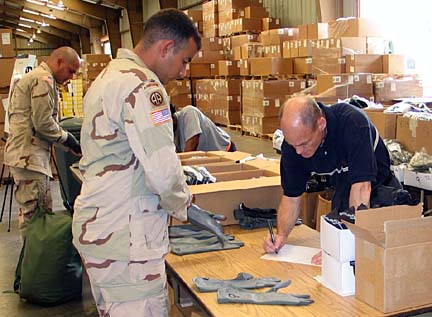
GREGG K. KAKESAKO / GKAKESAKO@STARBULLETIN.COM
Sgt. Carl McBride tries on a Nomex fire-retardant glove, one of nearly two dozen pieces of equipment issued to him before he deploys to Afghanistan.
Army gears up
for Afghan dutySchofield soldiers are being
equipped with the latest in
clothing and battle equipment
Army Sgt. Carl McBride didn't have all the gear he needed when he arrived in Afghanistan two years ago with the 82nd Airborne Division.
McBride and the rest of the 82nd had to get equipment, such as desert boots and Nomex aviator gloves, in a piecemeal fashion. Some even purchased what they needed.
"It was sort of tossed to us," said McBride, 23, who has been in the Army for nearly five years.
However, when McBride -- now a member of Charlie Company, 2nd Battalion, 35th Infantry -- leaves for Afghanistan this month, he will be fully equipped with the Army's latest one-man tent down to two sets of desert boots -- one specially made to combat the cold Afghan winters. The tents are off-the-shelf versions of those favored by backpackers and hikers, a far cry from the pup tents used by World War II soldiers.
Maj. Bill Dahms, deputy chief for force integration, said the backpack tents were fielded just three months ago. "We are getting out of the stone age," Dahms said.
All are part of the Army's Rapid Fielding Initiative that gives soldiers the latest in battle clothing and fighting gear. The 25th Infantry Division (Light) and U.S. Army Hawaii have spent more than $18 million to outfit the 8,500 soldiers deploying to Iraq and Afghanistan.
GREGG K. KAKESAKO / GKAKESAKO@STARBULLETIN.COM
Maj. Bill Dahms shows off the new one-man tent issued to infantry soldiers deploying to Afghanistan from Schofield Barracks. The tent, identical to those favored by backpackers and hikers, can be stored in a small bag and tied to a soldier's rucksack or backpack.
Since Monday, a team of specialists from the Rapid Fielding Initiative have been equipping 4,500 soldiers, the majority of them belonging to the 25th Infantry Division's 3rd Brigade Combat Team, for their year in Afghanistan.
"They come in the door with nothing," said Dahms, "and go out with everything."
Sixteen stations were set up in a 50,000-square-foot warehouse near Schofield Barracks' East Range and soldiers were herded into groups of 12 and moved from each station, collecting as many as two dozen items -- some as small as a Gerber multi-purpose knife and tool to extreme weather sleeping bags designed to protect a soldier when the mercury dips to 35 degrees below zero.
"Living in Hawaii, we were not used to the cold weather," Dahms said, "so we are issuing them everything from silk weight underwear to cold weather fleece overalls and shirts and neck gators.
"They are going to need them in Afghanistan's high altitude cold weather."
Before entering the warehouse, Kevin Dore instructed the soldiers "to pack everything into their duffel bags as soon as they got them. Don't examine them. You can do that when you get back.
"It's supposed to be rapid here and we want to keep it like that."
At another station, team member Terry Boddie was instructing soldiers on the proper way to fit and wear the Army's new advanced combat helmet, which they will receive in Afghanistan later this year. It will replace the current Kevlar helmet and, at three pounds, it is about a half pound lighter.
Boddie told the soldiers that the new helmet is designed "to protect you from a 9 mm round, but it has been known to withstand a much higher caliber round."
To illustrate his point he passed around two color photos showing helmets that had stopped sniper rifle rounds.
He said about an inch was cut from the front of the new advanced combat helmet so it sits more comfortably atop a soldier's head. It also can accommodate a modular radio system where both the speakers and a microphone can be placed inside the helmet held by Velcro pads.
The soldiers also were issued Wiley X goggles, which look like sunglasses and replace the old desert goggles, Nomex aviator gloves, elbow and knee pads, new combat rigger belts, and a new modular load-bearing vest with Camelback bladder system that holds 70 ounces of water and is connected to a tube that allows a soldiers to drink without letting go of their guns.
Each soldier was given the Modular Lightweight Load-Carrying Equipment. The MOLLE vest allows soldiers to reconfigure how they carry equipment. It is designed to fit with the Interceptor Body Armor.
The Rapid Fielding Initiative grew out of the lessons learned from Afghanistan following the Sept. 11, 2001, terrorist attacks. Army representatives were sent into the field to ask soldiers what was needed in Afghanistan. In some instances, the soldiers had brought their own equipment, like the Camelback water system, global positioning satellite devices, hand-held radios and rifle slings.

